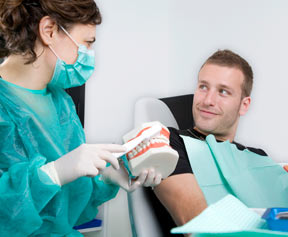
wikimedia.org
Between Thanksgiving and Christmas, it’s that time of year when people tend to show more gratitude. In fact, an old USA Today article says that charities receive the bulk of their funds at the beginning of the holiday season.
Even if you aren’t donating to every non-profit out there, you may be want to show gratitude in smaller, everyday ways. A good place to start is with a simple “thank you.” For instance, being a teacher can be a thankless job since so many are underpaid and have to handle lots of children every day. A small present to your child’s teacher with a thank you card could be a great gesture during this time of year. Since so many workers in retail are swamped due to everyone buying gifts, a “thank you” and some patience could go a long way.
One position that is often overlooked and could use more recognition is a dental hygienist. If you are going in for a teeth cleaning, you should give a shout-out to your hygienist. You may be surprised that dental hygienists are undervalued, but dentistryiq.com released an interesting article about one hygienist’s experience:
How to embrace the phrase, ‘Oh, you’re just a hygienist!’
I am certain that every hygienist has heard the phrase, “Oh, you’re just a hygienist.” I recently attended a function, and someone I was introduced to uttered the dreaded phrase. The “just” hit me in the chest as if I was wearing a shirt with a bull’s-eye on it. Everyone around us continued to engage in their conversations, and I noticed I was the only person in the room that actually reacted to the “just.”
Yes, I am just a hygienist:.
- Yes, I just review the patient’s medical history with them verbally because sometimes when patients are nervous they forget to write valuable medical information down on forms.
- Yes, I just talk to my patient for 45 minutes while I am “cleaning teeth” in order to help them feel comfortable and more importantly assess their stress level while gaining insight into their overall health.
- Yes, I just perform oral cancer screenings, periodontal charting, decay assessments, oral hygiene assessments, sealant placements, fluoride treatments, detailed explanations regarding dental treatments, and deal with any other overall health concerns they may have, often referring them back to their physician.
- Yes, I just sterilize the operatory, equipment, and dental instruments according to state regulations to ensure the health and safety of my patients and myself.
- Yes, I just obtained my bachelor’s degree in allied dental health, completed continuing education requirements, maintained my local anesthesia license, maintained my dental hygiene license, maintained my nitrous oxide administration credits, and continue to research dental technology to ensure that my patients are receiving the best dental hygiene care possible.
. . . I know the varied abilities and diverse opportunities being a hygienist represents. Still, I’ve chosen to fully embrace the phrase, “you’re just a hygienist.” Why? I do so to follow the brilliant and humble example of the Dalai Lama who once said, “I describe myself as a simple Buddhist monk. No more, no less.” My fellow hygienists, I hope you are proud to be just hygienists!
While this article is just one hygienist’s experience, the American Dental Hygienists’ Association (ADHA) has backed up some of the concerns. The ADHA just recently released a paper that discussed how hygienists have extensive education, yet there is still confusion in the practice on how to best utilize their education.
Although this dental position may be undervalued at the moment, there is hope for change. Drbicuspid.com released a study that showed that hygienists with expanded roles improved their practice’s care:
Can expanding hygienists’ practice improve adult care?
Does expanding a hygienist’s scope of practice translate to improved oral healthcare at the state level? Researchers from New York believe it does, according to the results of a survey published this month in Health Affairs.
With the debates about dental therapists and dental telemedicine ongoing, researchers from the University at Albany in New York updated a previous study to investigate if hygienists with an expanded practice options could reduce the oral disease burden.
“Scope of practice for dental hygienists … had a positive and significant association with having no teeth removed because of decay or disease,” wrote lead study author Margaret Langelier and colleagues (Health Affairs, December 2016, Vol. 35:12, pp. 2207-2215).
You can read more about the changing roles of hygienists at the American Dental Hygienists’ Association (ADHA) website. The association is concerned with this profession’s value, since “confusion still exists on how to implement it into daily practice.”
As the focus of public health oral healthcare has shifted from treatment to prevention, reaching underserved populations has received increased attention. Fifteen years ago, study authors created a new index to quantify hygienists’ scope of practice. With the current study, they wanted to see if any change in index scores also correlated with an expansion of hygienists’ scope of practice.
In 2001, the authors created the Dental Hygiene Professional Practice Index (DHPPI), which is comprised of four categories:
- Regulation
- Supervision by practice setting
- Tasks permitted under varying levels of supervision
- Reimbursement
The authors also compiled state-by-state scores and found that states that had new or expanded dental hygiene practice models had higher scores in general than states that have not enacted an expanded practice model.
Hopefully both patients and dentists continue to recognize hygienists’ important role in preventative dentistry. And not only should their scope of duties be expanded, but there needs to be some standardization across states so hygienists don’t feel confused about how much they can or cannot contribute to diagnosis.
In short, since your hygienist does a lot to help your oral care despite daily challenges, be sure to give a “thank you” this year.
